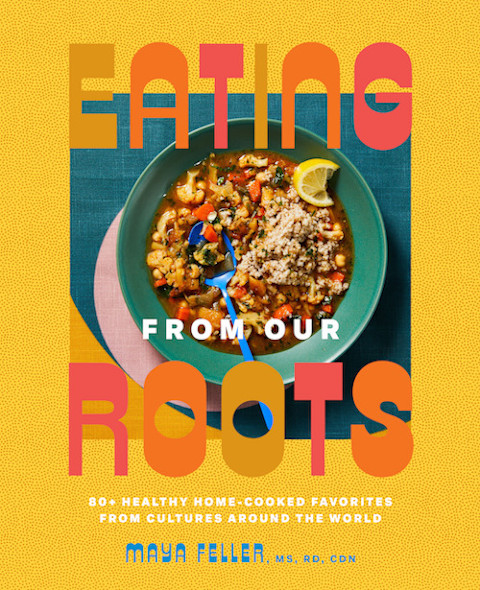This West African Peanut Miso Stew Comes Together Quickly + Is Packed With Protein

This legume-rich stew provides a great source of plant-based protein as well as vitamins and minerals that support metabolic function and energy production thanks to the peanuts and black-eyed peas. It's creamy with a hint of starch, and simply delicious. The rich flavors come together in a relatively short amount of time, making it a staple in your rotation.
Peanut Miso Stew
(West and Central Africa)
Serves 6 to 8
Ingredients:
- 5 tablespoons no sugar- or salt-added peanut butter
- 5 tablespoons miso
- ½ cup diced yellow onion
- 1 carrot, diced
- 2 tablespoons avocado oil
- ½ cup raw peanuts
- 1 cup cooked black-eyed peas, cooled
- 5-inch piece of kombu
- 2 tablespoons honey
- Juice and zest of 2 limes
- 1 tablespoon thinly sliced fresh cilantro
- 1 tablespoon thinly sliced fresh parsley
- 1 teaspoon chopped fresh chives
- 1 jalapeño, sliced thinly into rings, for garnish
- 2 cups toasted peanuts seasoned with paprika, for garnish
- Kosher salt to taste
Substitution Tip: If you are unable to find raw peanuts, simply omit them from the recipe and rely on the peanut butter and crunchy peanuts for garnish.
Ingredient Highlight
Method:
- Mix the peanut butter and miso. Reserve.
- In a large stockpot over medium-high heat, sauté the onions and carrots in avocado oil for 5 to 7 minutes, until translucent.
- Add the raw peanuts, black-eyed peas, kombu, and honey, as well as 3 cups of water, and bring to a boil. Cook for approximately 10 minutes, or until the liquid is reduced by a third.
- Add the peanut-miso mixture and continue cooking for 10 minutes, until thickened.
- Add the lime juice and zest, cilantro, parsley, and chives to the hot stew.
- To serve, ladle the hot stew into a bowl and garnish with the thinly sliced jalapeño rings and crunchy peanuts.
Historical highlights of West Africa
West Africa is a vast region encompassing urban as well as savanna and forested areas, landscapes that greatly influence the available foods.
Northern savanna areas are friendlier to cereal agriculture (sorghum, millet, and maize), while hotter forest areas are more conducive to tubers such as yams, cassava, and plantains. Climate plays a major role in determining the cooking oils and animal foods traditional to the region as well; people in forested areas generally cooked with palm oil, while in the savanna, peanut oil reigned. Sticky spheres of tubers called fufu are a common dish, often accompanying stews made from groundnut or palm oil, okra, spice, and some meat or fish.
During the Middle Passage, enslaved West Africans often brought foods from the continent with them as a matter of survival, which contributed to the spread of traditional West African food to America. Trans-Atlantic trade brought chilies, maize, and cassava to the African continent. Meanwhile, British imperialism took flavors from colonies around the globe and deposited them into Western and Central Africa. Palm chop, a West African dish made with palm oil, animal proteins, and vegetables, for example, was influenced by the curry found throughout South Asia.
As trade with other regions increased over the past two millenniums, some foods traditionally thought of as West African migrated to Central Africa. Central African eating patterns began to include cassava, peanuts, tomatoes, beans, taro, rice, sorghum, and millet; many of these became staple crops with some replacing the indigenous crops (e.g., the American peanut displacing the Bambara groundnut).
Throughout these changes, however, stews and starches remain the core of the Central African patterns of eating. Stews are usually composed of a few ingredients and then thickened with palm fruit or crushed peanuts; sometimes other thickeners such as crushed seeds or okra may be used. They are then paired with a boiled and pounded starch, such as cassava. Typically, a small piece is torn off and dipped or dunked in the stew before being eaten. Greens are also a core component of Central African cuisine, including leaves from cassava, okra, pumpkin, sorrel, or sweet potato. These greens, along with onion, hot pepper, meat, fish, and oil, are the typical ingredient base for daily stews. Red palm oil is also unique to the region, made from boiling and hand-squeezing fresh palm nuts.
Recipe from EATING FROM OUR ROOTS. Copyright © 2023 by Maya Feller. Photography copyright © 2023 by Christine Han. Published by goop Press/Rodale Books, an imprint of Penguin Random House, LLC. Reprinted with permission.

